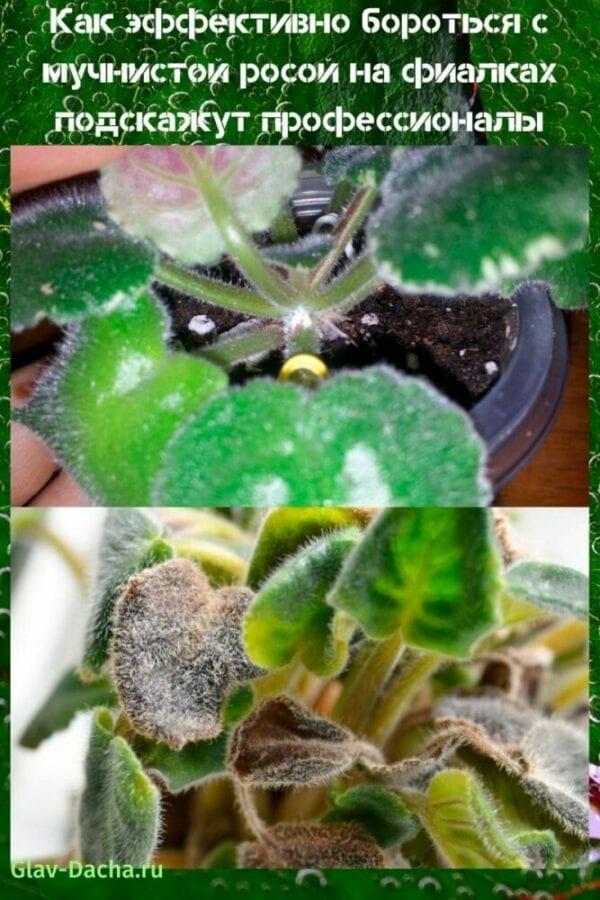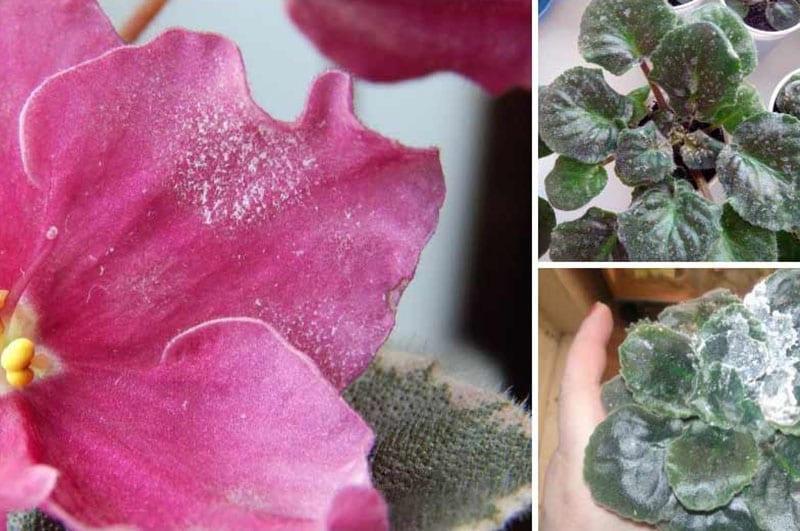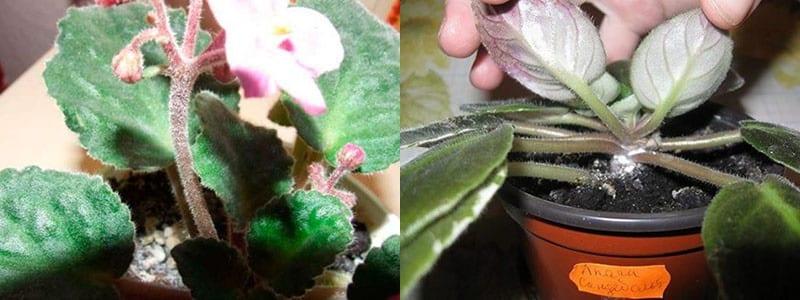Professionals will tell you how to effectively deal with powdery mildew on violets
 Fungal diseases are ruthless and devastating. Therefore, at the first signs of an illness, the gardener must know how to deal with powdery mildew on violets. It usually attacks a culture whose immunity is very weakened. This is due to improper care. Frequent watering with cold water, especially in a cool room, provokes the emergence and development of fungal spores. In such conditions, as well as with a lack of lighting, the plant's defense system completely weakens. But before you understand how to deal with powdery mildew on violets, it is important to consider the nature of this disease.
Fungal diseases are ruthless and devastating. Therefore, at the first signs of an illness, the gardener must know how to deal with powdery mildew on violets. It usually attacks a culture whose immunity is very weakened. This is due to improper care. Frequent watering with cold water, especially in a cool room, provokes the emergence and development of fungal spores. In such conditions, as well as with a lack of lighting, the plant's defense system completely weakens. But before you understand how to deal with powdery mildew on violets, it is important to consider the nature of this disease.
You need to know the enemy by sight

With the intensive development of myceliums:
- the flower ceases to cope with photosynthesis;
- the culture does not receive enough nutrients;
- ulcers and brown spots appear on the foliage;
- the flowerpot begins to dry out from exhaustion.
 It is noteworthy, but novice growers perceive this plaque as a common pollution, and do not attach much importance to it. To understand what this is actually will help an elementary rub. If, after it, grayish-white spots still remain on the surface, then it is powdery mildew. In this case, appropriate measures are taken.
It is noteworthy, but novice growers perceive this plaque as a common pollution, and do not attach much importance to it. To understand what this is actually will help an elementary rub. If, after it, grayish-white spots still remain on the surface, then it is powdery mildew. In this case, appropriate measures are taken.
Since spores quickly spread from one flower to another, sick specimens are first sent to the quarantine area.
How to deal with powdery mildew on violets: from theory to practice
 Florists note that fungal diseases are most often observed in the autumn or spring months. At this time, the temperature in the premises drops sharply, and the heating season either has not yet begun, or has already ended.
Florists note that fungal diseases are most often observed in the autumn or spring months. At this time, the temperature in the premises drops sharply, and the heating season either has not yet begun, or has already ended.
In this case, the conditions of the culture are completely changed.:
- move the flowerpot to a warm room with good lighting;
- watering is carried out only after the soil has dried by 2 cm;
- replace the top layer of soil with a new one.
 Even after this, you can find a white bloom on the violets, but professionals know what to do in such cases. As practice shows, affected leaves / peduncles are immediately removed in order to contain the spread of fungal spores. The foliage is cut at the very root. The pot, pallet and the location of the flower must be treated with a disinfectant solution.
Even after this, you can find a white bloom on the violets, but professionals know what to do in such cases. As practice shows, affected leaves / peduncles are immediately removed in order to contain the spread of fungal spores. The foliage is cut at the very root. The pot, pallet and the location of the flower must be treated with a disinfectant solution.
At the initial stage of the development of the fungus, a disinfecting procedure is carried out:
- the culture is thoroughly sprayed (shower is possible) with warm water;
- generously dust with colloidal sulfur;
- covered with a polyethylene bag to create a greenhouse effect.
 The shelter is removed after a day, examining the plant. If the symptoms persist, the exercise is repeated after a few days. Treatment of violets from powdery mildew is also carried out with a drug method, which is more effective.
The shelter is removed after a day, examining the plant. If the symptoms persist, the exercise is repeated after a few days. Treatment of violets from powdery mildew is also carried out with a drug method, which is more effective.
Chemicals to help
 The culture is treated with a fungicide once, and in severe form, twice with an interval of 7-10 days. Before therapy, the foliage is cleaned of dirt and dust by rinsing it under the shower or sprinkling abundantly from a spray bottle. They try to do this carefully so that water does not get into the middle of the flower.
The culture is treated with a fungicide once, and in severe form, twice with an interval of 7-10 days. Before therapy, the foliage is cleaned of dirt and dust by rinsing it under the shower or sprinkling abundantly from a spray bottle. They try to do this carefully so that water does not get into the middle of the flower.
After that, they begin to process one of these drugs:
- Bayleton (1 g / l);
- Topaz (2 ml / 5 l);
- Fundazole (20 g / l).

All fungicides are toxic and hazardous substances. Poisonous compounds have a negative effect on the human body. Therefore, all operations are carried out in personal protective equipment, trying not to exhale vapors of funds.
Having learned how to treat violets from powdery mildew, you need to understand how to do it correctly. According to the instructions, the preparations are diluted with settled water. Each leaf is carefully sprayed on both sides. The solution also disinfects the soil substrate and the pot. The top layer of soil is removed, replacing it with a new one.
If the therapy does not give the desired result, after 2 weeks, a second etching is carried out, but with a different means.
From the archives of traditional medicine
 Of course, the use of fungicides is not immediately resorted to, especially if the fungal disease is just beginning to develop. Well-known recipes of traditional medicine are often used. Yet, to begin with, learn some of the features of how to deal with powdery mildew on violets in this way.
Of course, the use of fungicides is not immediately resorted to, especially if the fungal disease is just beginning to develop. Well-known recipes of traditional medicine are often used. Yet, to begin with, learn some of the features of how to deal with powdery mildew on violets in this way.
Method one:
- take 4 g of soda;
- dissolve in soapy water (5 g of soap per 1 l);
- generously spray the green mass.
The procedure is repeated only after 1-1.5 weeks. Iodine solution is also widely used. 5 drops of the concentrate are added to 200 ml of liquid. Dry mustard is used in a similar way. 3 g of powder is dissolved in 1 l of water.  In addition to external processing, the flowerpot is additionally watered with this agent. It also has a pronounced fungicidal effect copper sulfate.
In addition to external processing, the flowerpot is additionally watered with this agent. It also has a pronounced fungicidal effect copper sulfate.  Copper sulfate is diluted in a ratio of 5 g per 200 ml of water. A soap solution (50 g of soap per 5 l) is introduced into the concentrate and mixed thoroughly.
Copper sulfate is diluted in a ratio of 5 g per 200 ml of water. A soap solution (50 g of soap per 5 l) is introduced into the concentrate and mixed thoroughly.
Another effective remedy is whey. The composition is prepared in a ratio of 1:10. Spraying is carried out three times with an interval of 3 days.
Biologicals
 Bacterial preparations will also help to cure a violet from powdery mildew. These formulations are produced on the basis of substances that saturate the soil with useful substances. In this regard, the treatment procedure will take place in a more gentle mode. In addition, the complex will serve as a kind of fertilizer for the culture.
Bacterial preparations will also help to cure a violet from powdery mildew. These formulations are produced on the basis of substances that saturate the soil with useful substances. In this regard, the treatment procedure will take place in a more gentle mode. In addition, the complex will serve as a kind of fertilizer for the culture.
As such means are used:
- Fitosporin (1 g / l);
- Phytocide (2 ml / l);
- Trichodermine (25 ml / l).

The flower is sprayed and watered with such solutions. For preventive purposes, it is recommended to use Glyocladin or Gamair.  Given that biologicals are slow-acting, several treatments are planned. The interval between each of them will be 7-10 days.
Given that biologicals are slow-acting, several treatments are planned. The interval between each of them will be 7-10 days.
Biological products strengthen the plant's immunity. However, in case of severe damage, more powerful agents are used - chemical fungicides.
With such an arsenal of useful tips, everyone now knows how to deal with powdery mildew on violets. But it is best to properly care for the culture and be especially careful in the off-season, when a cold snap comes. Then you don't have to apply all these techniques.